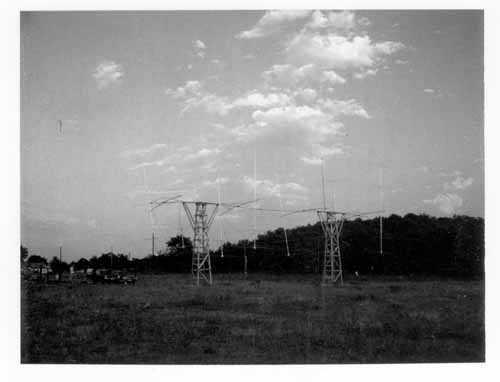
The 30th anniversary of the first six meter Moon bounce contact.

The above announcement appeared in September 1972 QST.

Contrary to August 1972 QST, Joe Muscanere, W5HNK, is on the left and I am on the right. This picture was taken at W5SXD where I was mostly working satellites and 40 states on 144 MHz cw meteor scatter.


The antenna at K5WVX (now K5CM) in Muskogee, Oklahoma.
Connie, K5WVX, was the real force behind this project. He put up his array not knowing that it would perform well enough to make a contact. In Houston, we started out knowing that if we put up the same antenna, we would be successful since Connie was hearing nice echoes. His antenna could be elevated which gave him more Moon time every month. We had only several days out of each Lunar cycle.
play Moon echoes recorded at the South Texas end
play ssb echoes recorded at K5WVX
play cw echoes recorded at K5WVX

Above is the shack at WA5HNK. The big problem is that it is too neat! The famous Swan amplifier is at the upper right. We found out that the only thing the fan was good for was to blow the smoke out when it crashed and burned during the initial tests. The amplifier used for the contact was a new Heath SB200 that I purchased after the Swan crashed. I built it for six only during the 21 day period that we had no Moon time and got about 400 to 500 watts out if I remember correctly.
The antenna was built by Joe Muscanere, W5HNK (then WA5HNK), and Richard Allen, W5SXD. It consisted of eight six element 24 foot boom HyGain yagis stacked four over four with one wavelength spacing horizontally and vertically. The bottom row of four was about ten feet above the flat ground. The antennas were pointed fixed to the east. The antenna was identical to the one at K5CM, Connie Marshall (then K5WVX) who was assisted by K5SW, Sam Whitley (then W5WAX). Power output at the Houston end was about 700 watts from a pair of 3-500Z tubes before that amplifier destroyed itself. We made the first six meter Moon bounce contact with K5WVX the day after these echoes were recorded.

As can be seen in the following image, the array pointed east at power lines less than a mile away. Our noise levels were terrible. The 75 ohm phasing lines can be clearly seen here. Joe became an expert at installing PL-259 connectors.

The antenna was completely destroyed by a small tornado several weeks later.

Fortunately, Joe had the antenna insured. We are probably the only EME project in history to turn a profit.
The schematic below was made by a three-dimensional simulation program that I wrote to visualise large antenna arrays. The out side square is about 200 feet on a side and represents the bounds of one acre. The large cube under the antenna is one meter on a side and the smaller is one foot on a side. Our antenna at W5HNK's place was, of course, mounted on four fixed vertical masts and not the el/az version shown. The rest of the antenna is accurate in scale with the HyGain yagi dimensions read from a .yag file from K6STI's great program YO (YagiOptimiser). The program that I wrote was named MBA. That stood for Model Big Array with apologies to W5UN who called his big two meter antenna the Mighty Big Array.